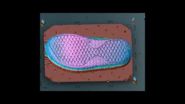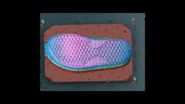(Press-News.org) VIDEO:
This video shows the sole of a shoe as it appears from different perspectives in rendering software. The shoe was placed upside down on an optical table (seen as flat...
Click here for more information.
Researchers at the National Institute of Standards and Technology (NIST) have demonstrated a laser-based imaging system that creates high-definition 3D maps of surfaces from as far away as 10.5 meters.* The method may be useful in diverse fields, including precision machining and assembly, as well as in forensics.
NIST's 3D mapping system combines a form of laser detection and ranging (LADAR), which is sensitive enough to detect weak reflected light, with the ranging accuracy made possible by frequency combs, as previously demonstrated at NIST.** The frequency comb, a tool for precisely measuring different frequencies of light, is used to continuously calibrate the laser in the imaging system.
Operating with laser power of just 9 milliwatts—which is safe for the eyes at the instrument's infrared wavelength—NIST's 3D mapping system scans a target object point by point across a grid, measuring the distance to each point. The system uses the distance data to make a 3D image of about 1 million pixels in less than 8.5 minutes at the current scanning rate. Distances to points on a rough surface that reflects light in many directions can be determined to within 10 micrometers in half a millisecond, with an accuracy that is traceable to a frequency standard.
The system has wide dynamic range, enabling precise 3D mapping of targets with varied surface types and reflective properties. NIST researchers demonstrated the range by scanning footprints in soil, vegetation such as cactus (imaging individual spines), and complex mechanical devices such as a piston for a motorcycle.
The new NIST method offers a unique set of capabilities compared to conventional 3D mapping techniques. The NIST system is similar to optical coherence tomography, for example, but can operate much farther away from the target and is inherently accurate because of the frequency comb. The NIST system does not need a reference artifact to be placed next to the target, something typically required for interferometry-based systems.
LADAR typically measures distance based on the round-trip flight time of laser light, which reflects off the target and is detected by a sensor. In the NIST LADAR system, the laser sweeps continuously across a band of frequencies. The initial laser output is combined with the reflected light and the resulting "beat" signals are converted to voltage and analyzed by digital signal processing to generate time delay data, which is used to calculate the distance. (The difference in frequency between the transmitted and received signals increases with distance.)
This basic technique is well established .*** However, by including a frequency comb to continuously calibrate the swept laser, the NIST system can operate much more rapidly, yielding one measurement point every half a millisecond and simultaneously maintain sub-micrometer accuracy traceable to a frequency standard. Finally, the system uses real-time, fast processing digital electronics to produce fully calibrated, 3D megapixel images.
As an example application, NIST's 3D mapping system could be used to make virtual casts of forensic evidence such as footprints in dirt. Conventional plaster casts that record impression evidence normally require a lot of effort to make and are difficult to compare to each other or to shoes. Furthermore, conventional analysis can destroy the evidence. By contrast, a remotely created 3D image of a footprint can nondestructively reveal more details than a photograph, such as exact measurements of shoe tread. The tread may show individual wear marks from a bicycle pedal, for example, a type of detail that could link a specific shoe to a crime scene.
Several manufacturers already have expressed interest in the NIST system, which is currently about the size of a desktop but suitable for future potential conversion to a portable, chip-scale instrument. The research was funded by NIST and the Defense Advanced Research Projects Agency.
INFORMATION:
* E. Baumann, F.R. Giorgetta, J.D. Deschenes, W.C. Swann, I. Coddington and N.R. Newbury. Comb-calibrated laser ranging for three-dimensional surface profiling with micrometer-level precision at a distance. Optics Express. Vol. 22 Issue 21, Oct. 20, 2014. DOI:10.1364/OE.22.024914
** See 2009 NIST Tech Beat article, "NIST's LIDAR May Offer Peerless Precision in Remote Measurements," at http://www.nist.gov/pml/div686/lidar_060209.cfm. NIST researchers also reported in 2013 that the LADAR system without the 3D imaging capability is accurate to within 1 micrometer (E. Baumann, F.R. Giorgetta, I. Coddington, L.C. Sinclair, K. Knabe, W.C. Swann and N.R. Newbury, Comb-calibrated frequency modulated continuous-wave LADAR for absolute distance measurements, Opt. Lett., vol. 38,no. 12, pp. 2026-2028).
*** This technique is called frequency modulated continuous wave (FMCW) laser detection and ranging (LADAR).
(SALT LAKE CITY)—University of Utah biochemists have reported a new drug discovery tool against the Ebola virus. According to a study published in this week's online edition of Protein Science, they have produced a molecule, known as a peptide mimic, that displays a functionally critical region of the virus that is universally conserved in all known species of Ebola. This new tool can be used as a drug target in the discovery of anti-Ebola agents that are effective against all known strains and likely future strains.
The University of Utah (U of U) work, which was ...
The link between low average glucose blood levels and greater risk for severe hypoglycemia and hypoglycemic coma substantially declined between 1995 and 2012 in young Germans and Austrians with type 1 diabetes, according to a study published by Beate Karges and colleagues from the RWTH Aachen University, Germany in this week's PLOS Medicine.
The researchers obtained measurements of average blood glucose levels (measured as HbA1c) and the incidents of severe hypoglycemia and hypoglycemic coma from 37,539 children and young adults with type 1 diabetes between 1995 and 2012 ...
Treatment with dimercaptosuccinic acid (DMSA), an oral chelation agent, was linked to reductions in the amount of lead in blood in young children in Zamfara State, Nigeria following environmental lead contamination, according to a study by Jane Greig and colleagues from Médecins Sans Frontières (MSF) published in this week's PLOS Medicine.
The researchers report findings from an MSF program initiated in May 2010 to reduce lead poisoning in children following widespread environmental lead contamination due to gold mining in Zamfara State, Nigeria, leading to ...
A fundamental question in neurobiology is how animals, including humans, make decisions. A new study publishing in the open access journal PLOS Biology on October 7 reveals how fruit fly females make a very important decision: to either accept or reject male courtship. This decision appears to be generated by a very small number of excitatory neurons that use acetylcholine as their neurotransmitter located in three brain regions. This study provides the framework to understand how decisions are generated and suggests that a decision is reached because that option is literally ...
Researchers at the University of California, San Diego School of Medicine have, for the first time, clearly defined the epidemiology of gastrointestinal stromal tumors (GIST), which occur primarily in the lining of the stomach and small intestine. One key finding: Patients of Asian descent, who have not previously been identified as an at-risk population, are 1.5 times more likely than other patient groups to be diagnosed with this type of tumor. Results of the study were published this week in Cancer Epidemiology, Biomarkers & Prevention, a journal of the American Association ...
WASHINGTON (Oct. 7, 2014) — Nearly 20 percent of Americans have a disability, yet only 25 percent of medical schools include in their curricula caring for people with disabilities. Numerous reports have documented that people with disabilities have poorer health and receive inferior care.
In a Narrative Matters essay published in Health Affairs, Leana Wen, M.D., director of patient-centered care research and assistant professor of emergency medicine at the George Washington University School of Medicine and Health Sciences, shares her own experiences to highlight ...
COLUMBUS, Ohio – A molecule that helps cancer cells evade programmed self-destruction, an internal source of death, might also help malignant cells hide from the immune system, an external source of death.
A new study by researchers at The Ohio State University Comprehensive Cancer Center – Arthur G. James Cancer Hospital and Richard J. Solove Research Institute (OSUCCC – James) shows that a molecule called nuclear factor kappa B (NF-kB) helps cancer cells by inhibiting the immune system's ability to detect and destroy them. The molecule regulates genes ...
DALLAS – Oct. 7, 2014 – Researchers at UT Southwestern Medical Center have found an "Achilles heel" in a metabolic pathway crucial to stopping the growth of lung cancer cells.
At the heart of this pathway lies PPARγ (peroxisome proliferation-activated receptor gamma), a protein that regulates glucose and lipid metabolism in normal cells. Researchers demonstrated that by activating PPARγ with antidiabetic drugs in lung cancer cells, they could stop these tumor cells from dividing.
"We found that activation of PPARγ causes a major metabolic ...
State policies can influence the number of physicians licensed to prescribe buprenorphine, a drug that can treat addiction to heroin and other opioids in outpatient settings, according to a new RAND Corporation study.
Examining county-level numbers of physicians approved to prescribe buprenorphine, researchers found a significant link between the number of approved physicians and both specific state guidance regarding the use of buprenorphine and the distribution of clinical guidelines for buprenorphine treatment. The findings were published online by the Journal of ...
Alexandria, Va., USA – Poor oral health and hygiene are increasingly recognized as major risk factors for pneumonia among the elderly. To identify modifiable oral health-related risk factors, lead researcher Toshimitsu Iinuma, Nihon University School of Dentistry, Japan, and a team of researchers prospectively investigated associations between a constellation of oral health behaviors and incidences of pneumonia in the community-living of elders 85 years of age or older. This study, titled "Denture Wearing During Sleep Doubles the Risk of Pneumonia in Very Elderly," ...



